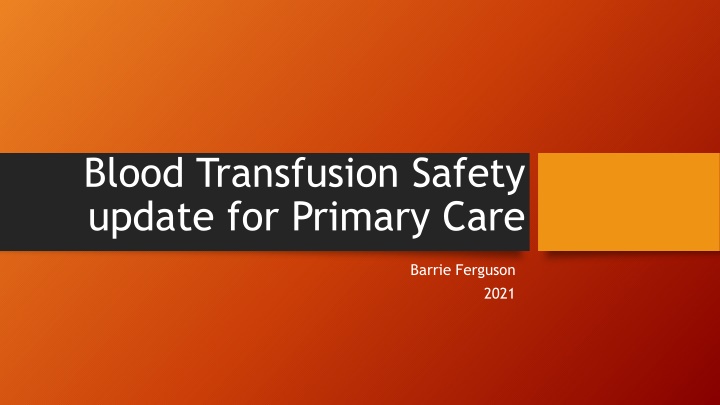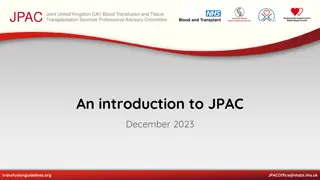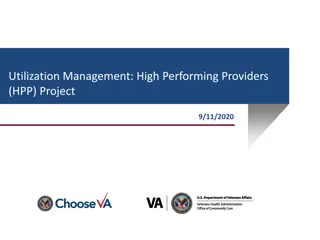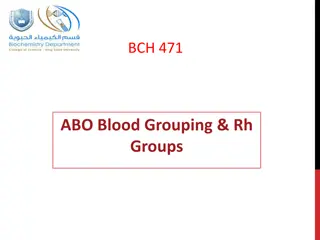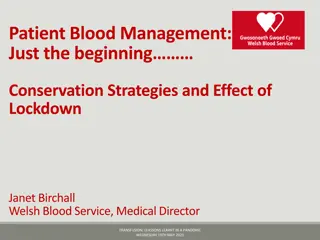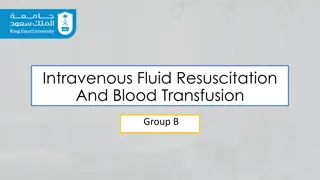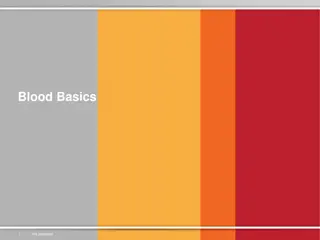Enhancing Blood Transfusion Safety in Primary Care: Key Updates for Healthcare Providers
Blood transfusion safety is a critical aspect of healthcare delivery, with the potential for preventable errors posing risks to patients. Initiatives like the Serious Hazards of Transfusion (SHOT) program and Patient Blood Management have played significant roles in improving safety and reducing adverse events in transfusions. The implementation of restrictive transfusion thresholds and better surgical techniques has led to a decline in inappropriate transfusions, emphasizing the importance of proper patient assessment and management in blood transfusion practices.
Uploaded on Oct 11, 2024 | 11 Views
Download Presentation

Please find below an Image/Link to download the presentation.
The content on the website is provided AS IS for your information and personal use only. It may not be sold, licensed, or shared on other websites without obtaining consent from the author.If you encounter any issues during the download, it is possible that the publisher has removed the file from their server.
You are allowed to download the files provided on this website for personal or commercial use, subject to the condition that they are used lawfully. All files are the property of their respective owners.
The content on the website is provided AS IS for your information and personal use only. It may not be sold, licensed, or shared on other websites without obtaining consent from the author.
E N D
Presentation Transcript
Blood Transfusion Safety update for Primary Care Barrie Ferguson 2021
Introduction Blood Transfusion in the UK is generally very safe, but not without risk The most common preventable risk relates to errors in identifying patients correctly Blood is donated to us and we must ensure we use it safely and appropriately. Though donated, it costs the hospital 145 per unit to buy from NHS Blood and Transplant.
Haemovigilance and Serious Hazards of Transfusion Serious Hazards of Transfusion (SHOT) was formed in 1996 National voluntary reporting system recording adverse reactions and events It identifies risks, problems and produces recommendations to improve patient safety
Impact of blood safety and haemovigilance Requirement for training and competency assessment Since SHOT established, alongside other blood safety initiatives, there has been a steady decrease in the numbers of ABO incompatible transfusions in the NHS
The decision to transfuse Red cell use has declined by over 20 % in the last 20 years There is increasing evidence that the use of restrictive transfusion thresholds improves patient morbidity and mortality Patient Blood Management comprises a series of initiatives designed to help ensure appropriate transfusion for every patient
Patient Blood Management Monthly Red Cell use in RD&EFT Nationally agreed restrictive thresholds for transfusion 1400 1300 Improved surgical techniques 1200 1100 Pre operative anaemia management 1000 900 Red cells Single unit transfusion policy in stable adult inpatients 800 700 600 Correction of cause of anaemia eg iron/B12 and Folate 500 Oct-13 Oct-14 Oct-15 Oct-16 Oct-17 Oct-18 Oct-19 Jul-13 Jul-14 Jul-15 Jul-16 Jul-17 Jul-18 Jul-19 Apr-14 Apr-15 Apr-16 Apr-17 Apr-18 Apr-19 Apr-20 Jan-14 Jan-15 Jan-16 Jan-17 Jan-18 Jan-19 Jan-20 Use of Cell salvage
National restrictive thresholds for RBC Transfusion National Indications include: stable acute anaemia, threshold of 70 g/litre and a target of 70 90 g/litre; acute coronary syndrome, threshold of 80 g/litre and a target of 80 100 g/litre chronic anaemia, maintain a haemoglobin that prevents symptoms, with a suggested initial threshold of 80g/l In patients with ischaemic stroke, traumatic brain injury, severe sepsis or undergoing radiotherapy a higher transfusion trigger may be beneficial
Size matters....... The rule that 1 unit of blood increases Hb by 10 g/l holds for someone of 70 kg; in someone weighing 50 kg the Hb may rise by 15 to 20 g/l after 1 unit It is very rare to need to transfuse to over 100 g/l
Haematinic deficiency: Iron deficiency Chronic iron deficiency anaemia is not an indication for transfusion unless symptoms of end organ symptoms such as angina, claudication Oral iron is first line treatment but if not tolerated or ineffective then IV iron can be given 1g monofer contains the same amount of iron as contained in 4 units RBC Haemoglobin levels will start to improve in 7 to 14 days Intravenous iron can be arranged in Sidmouth or Tiverton Community hospitals or via Wynard Ambulatory unit
Risks of blood transfusion Transfusion is very safe; the risk of dying from a transfusion is less than 1 in 100 000 and the risk of suffering major morbidity is less than 1:20 000 The most common cause of severe morbidity and mortality is Transfusion Associated Circulatory Overload (TACO) which is left ventricular failure within the 24 hours after transfusion
Transfusion Associated Circulatory Overload (TACO) When referring patients for day case transfusions at Wonford Sidmouth or Tiverton, consider the patient s risk of TACO. The referral form will ask for relevant information. SHOT recommend a beside check list of risks which will be assessed prior to transfusion. If the patient is at risk the staff transfusing the patient will assess whether the transfusion is immediately necessary or whether the condition of the patient can be improved prior to transfusion, they will use single unit transfusion wherever possible, monitor the patient carefully and will consider use of diuretics during transfusion.
Patient Consent to Blood Transfusion Written consent is not required for blood transfusion, but patients should have the risks, benefits and alternatives to transfusion explained to them if possible and recorded in the patient records Provide written information to back up your discussion, for example this leaflet available on all wards Importantly, patients need to be told that once transfused they will no longer be able to donate blood.
Requesting and labelling samples for transfusion In the clinical area, there two critical points which can lead to ABO incompatible transfusions, one of these points is at sample taking Every year we receive a number of samples where the blood in the sample is not the blood of the patient identified on the label
The two sample or group check policy The transfusion laboratory needs confirmation of a patient s ABO group from 2 separate samples to reduce the risk from these mislabelled samples 1 sample can be historic, 80% of patients have a previous group and save If you are unsure whether you need to take one sample or two, please contact the transfusion laboratory If you need to take 2 samples, you will need 2 request forms, to identify the patient twice and take 2 different samples which will be labelled at different times.
Sample labelling at GP practice/community In GP surgeries or in patient s homes, the sample label must always be hand written If GP labels or hospital pre printed PAS labels are stuck onto the sample tube the sample will be rejected by the transfusion laboratory
How soon before transfusion can the sample be taken The sample needs to be taken within 72 hours of transfusion In chronically transfused haematology patients, if this tight timeline is difficult, an extension to 7 day validity can be requested in discussion with the patient s consultant
There are now 2 request forms GP Request Secondary Care request Either form will be accepted by the laboratory
How to complete GP request form Use patient sticker or handwrite: Hospital or NHS number Surname Fore name Date of birth Please add requesting DR name, so that we know who to contact Complete special requirements (listed on back of form) Group and save or cross match and number of units, when and where transfusion will take place Meaningful reason for transfusion
How to complete secondary care request form Fill in Sample date & time, staff taking sample and location fields on request form.
Sample labelling at GP practice/community In GP surgeries or in patient s homes, the sample label must always be hand written If GP labels or hospital pre printed GP patient labels or hospital PAS labels are stuck onto the sample tube the sample will be rejected by the transfusion laboratory
Handwritten labels for transfusion must include: Patient ID details must exactly match those on request form Patient first name Patient surname Patient date of birth Patient hospital number or NHS number (the same one as on the request form or either if both on request form) Sample taker signature Date and time
Timeline for requests for community or day case transfusion Day 1 Day 2 Day 3 Sample taken, community samples typically arrive in the laboratory at about 4 - 5pm Blood cross matched in laboratory Transfusion
TAKE HOMES Use restrictive RBC thresholds and the single unit policy where possible so that each transfusion is appropriate In haematinic deficiency, replace what is missing and use transfusion only when required for end organ symptoms When referring patients for day case transfusions consider risk of transfusion associated circulatory overload Take care when sample taking, always positively identify your patients.
